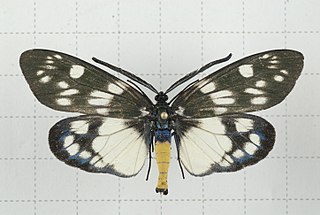
The Zygaenidae moths are a family of Lepidoptera. The majority of zygaenids are tropical, but they are nevertheless quite well represented in temperate regions. Some of the 1000 or so species are commonly known as burnet or forester moths, often qualified by the number of spots, although other families also have 'foresters'. They are also sometimes called smoky moths.

Theresimima is a genus of moths. T. ampellophaga, the vine bud moth, is a moth of the family Zygaenidae. It is found from Algeria, Spain and southern France through most of southern Europe to the northern coast of the Black Sea. In the north, it ranges up to Hungary and Slovakia and in the east, the range extends to the southern part of European Russia, the western Caucasus and Transcaucasia, through Turkey, Lebanon and Syria to Israel.
Hestiochora continentalis is a moth of the family Zygaenidae. It is found in Australia from southern Queensland through New South Wales to Victoria, South Australia and Western Australia.
Hestiochora furcata is a moth of the family Zygaenidae. It is found in Australia from southern Queensland through New South Wales to Victoria and South Australia.
Hestiochora queenslandensis is a moth of the family Zygaenidae. It is found in Australia from south-eastern Queensland and northern New South Wales.
Hestiochora xanthocoma is a moth of the family Zygaenidae. It is found Australia from the tropical parts of the Northern Territory and Queensland.

Pollanisus viridipulverulenta, the satin-green forester, is a moth of the family Zygaenidae. It is found in the eastern part of Australia.
Pollanisus nielseni is a moth of the family Zygaenidae. It inhabits the Australian state of Western Australia, mostly coastal areas, and has brilliantly shiny forewings. The diurnal adults are most active on sunny days. Eggs are laid on the plant Hibbertia spicata, and females touch each egg after oviposition with a tuft of hair on their abdomen, which attaches protective spines. The larvae are brightly coloured and feed on H. spicata before pupation.
Pollanisus lithopastus is a moth of the family Zygaenidae. It is found in Australia from northern New South Wales to Victoria and Tasmania. It is mostly found in mountainous areas at higher elevations, but has also been found at sea level, especially in Tasmania.
Pollanisus incertus is a moth of the family Zygaenidae. It is found along the coast of north-eastern Queensland, Australia.

Jordanita budensis is a moth of the family Zygaenidae. It is found in disjunct populations in central Spain, southern France, Italy, eastern Austria, Hungary, the Balkan Peninsula, Greece, Ukraine, the Crimea, the European part of southern Russia, the Caucasus, Transcaucasia, Turkey, southern Siberia, Mongolia and the Amur region.
Jordanita notata is a moth of the family Zygaenidae. It is found from the Iberian Peninsula and central Europe, through the northern part of the Mediterranean region to the Caucasus and Transcaucasia.
Jordanita hector is a moth of the family Zygaenidae. It is known from southern Turkey and Lebanon.
Jordanita horni is a moth of the family Zygaenidae. It is found in Turkey, Armenia, Nakhchivan and northern Iran.

Jordanita chloros is a moth of the family Zygaenidae.

Jordanita globulariae, also known as the scarce forester, is a day-flying moth of the family Zygaenidae.
Jordanita subsolana is a moth of the family Zygaenidae. It is found from southern Spain though the southern part of central Europe, Italy, the Balkan Peninsula and Greece to southern Russia and Ukraine, Turkey and Transcaucasia up to the Altai.
Adscita albanica is a moth of the family Zygaenidae. It has a disjunct distribution, which included south-eastern France, Switzerland, in Italy, Slovenia, North Macedonia, Albania, Bulgaria, Greece, Ukraine, the southern part of European Russia and the Caucasus.
Onceropyga pulchra is a species of moth in the family Zygaenidae. It is found in Australia in south-eastern Queensland and eastern New South Wales.

Eterusia aedea, the red slug caterpillar, is a species of moth in the family Zygaenidae. It was described by Carl Linnaeus in his 1763 Centuria Insectorum. It is found in Sri Lanka, India, Nepal, Taiwan, Japan and China.





